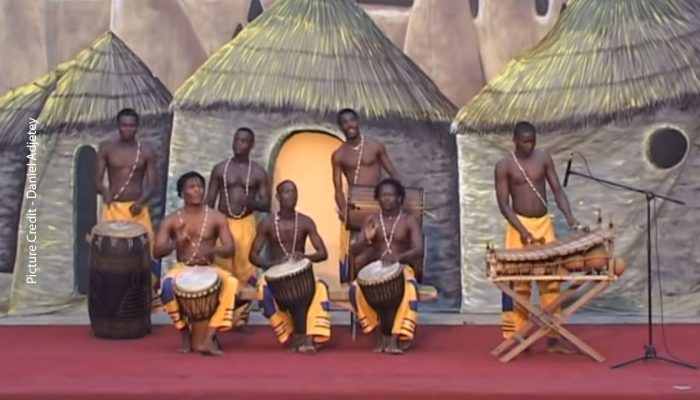asylummedialtd.com – Traditional African music is a powerful example of how culture, stories, and the arts can last for a long time. This music comes from ceremonies, lively parties, and the soul of a continent. Its complex rhythms and melodies link people of all ages. Cultures in Africa are affected by it, and its effects can also be seen in music around the world..
This article delves into the origins, evolution, and cultural significance of African music, exploring its instruments, styles, and global legacy.
The Origins and History of Traditional African Music

Early Instruments and Practices
The music of ancient Africa relied on simple yet innovative instruments crafted from natural materials. These tools were integral to communal life, storytelling, and spiritual practices. Here’s a closer look:
- Drums: Drums, which were made from hollowed-out logs, animal skins, or gourds, were an important part of events, parties, and communication. From the resonant djembe to the talking drum, each has its own sounds that come from local cultures.
- Xylophones: This musical instrument, which was made of wooden slats placed over resonating spaces, was used in both religious and secular settings. Its complicated tunes told stories about different cultures.
- Rattles and Bells: Crafted from gourds or metal, these instruments added texture to rituals, often warding off evil spirits or invoking blessings.
Oral Traditions and Storytelling
African music was an oral tradition, a vital tool for preserving history and culture. Songs carried stories of ancestors, conveyed proverbs, and celebrated key life events. This method ensured the transmission of knowledge across generations.
The Evolution of Traditional African Music

Influences of History and Culture
Over centuries, traditional African music evolved under the influence of both internal cultural shifts and external forces such as the transatlantic slave trade. African rhythms and melodies profoundly shaped music in the Americas, birthing genres like blues, jazz, and gospel.
Colonialism and Western Influence
During colonial times, Western styles of music were often pushed ahead of native music. Even so, African music changed over time, mixing traditional sounds with Western instruments like the piano and guitar. This mix led to the creation of famous music styles like
- Afrobeat: A blend of traditional rhythms with funk and jazz influences.
- Highlife: Combining African melodies with Western brass instruments.
- Jùjú: Merging Yoruba percussion with electric guitars.
Key Musical Elements

Rhythm: The Heartbeat of African Music
Polyrhythms—multiple, overlapping rhythms—are a hallmark of African music. This complexity creates a rich, dynamic sound that captivates listeners.
Melody
African melodies often use unique scales and modes, incorporating microtones that distinguish them from Western traditions.
Vocal Techniques
- Call and Response: A leader sings a phrase, followed by a group response, fostering communal participation.
- Yodeling and Throat Singing: Techniques to express joy, longing, or connection with the spiritual realm.
Instruments
From the kora (a 21-string harp) to the mbira (thumb piano), traditional instruments reflect Africa’s ingenuity and environmental resources.
Genres and Regional Variations

Each region in Africa boasts its own musical identity, shaped by geography, language, and customs. Below is an overview:
| Genre/Style | Region | Key Characteristics | Instruments | Cultural Context |
|---|---|---|---|---|
| Highlife | West Africa | Upbeat, jazz-inspired melodies | Guitar, trumpet, percussion | Played at festivals and social gatherings |
| Mbalax | Senegal | Fast-paced, polyrhythmic dance music | Tama drum, kora, electric guitar | Central to celebrations and political events |
| Taarab | East Africa | Lyrical, Arabic-influenced melodies | Oud, violin, percussion | Performed at weddings and communal festivals |
| Soukous | Congo (DRC) | Energetic dance rhythms | Guitar, drums, horns | Popular in urban nightlife |
Cultural Significance of Traditional African Music
Music as a Cultural Identity
Africans don’t just listen to music for fun; it’s a way of life. It shows the ideals of the community, keeps past alive, and shows how everyone feels. Music and instruments represent the unique history of each town.
Music in Ceremonies and Everyday Life
- Ceremonial Use: From weddings to funerals, music creates a sacred atmosphere, guiding participants through rituals.
- Healing Practices: Many African traditions use music to heal, invoking spiritual forces or inducing trance states.
Global Influence and Modern Adaptations

Influence on Global Genres
The rhythms and improvisational styles of African music have inspired genres like:
- Jazz: Syncopated rhythms from West Africa laid its foundation.
- Hip Hop: Sampling African beats and melodies remains a staple.
- Electronic Music: Producers incorporate African drum patterns into tracks.
Contemporary African Artists Bridging Worlds
Modern African musicians blend tradition with innovation:
- Salif Keita (Mali): Combines ancestral melodies with modern instruments.
- Angélique Kidjo (Benin): Infuses traditional rhythms into funk and jazz.
- Burna Boy (Nigeria): Popularized Afrobeat globally with hits blending African and contemporary sounds.
Preservation in the Digital Age
Digital platforms like YouTube and Spotify have expanded the reach of traditional African music. These tools ensure its preservation and introduce it to global audiences.
Conclusion: A Living Legacy
Traditional African music is still going strong, linking the past to the present and giving hope to the future. The beats, tunes, and instruments in it tell stories of strength, imagination, and community. Even though modern artists are reinterpreting these practices for audiences around the world, the essence of African music stays the same, showing that it has a timeless draw that can’t be denied.
To experience this cultural gem, watch modern movies and TV shows that show Africa’s musical history, like those with the top men in South African cinema, who combine traditional and modern styles in every performance.







